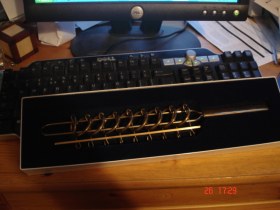|
|
|
|
|
|
|
| . . Homepage. . . . What We've Been Up To. . . . About Me & Al. . . . Teddington. . . . Pictures. . . . Puzzles. . . . Puzzles Too. . . . Music. . . . Misc. . . . My Films. . . . Credits etc. . |
|
||||
|
|
||||
|
This article is an 'off the top of my head' reply to someone who wrote to me asking about this sort of puzzle. Now, Chinese rings. You've made me realise that trying to tell someone how to solve this type of puzzle is very difficult, and will be a subject for discussion with many of my puzzle friends... After a lot of thought, the best succinct advice I can give depends on whether you know the traditional Christmas song, 'The 12 Days of Christmas". I think it is nearly as well known in English-speaking places as the puzzle itself. The one in the picture below is my largest, but they came in almost all shapes and sizes. It's the one where an overzealous admirer sends the subject of his love a partridge in a pear tree on the first day. On day two he sends two turtle doves and a partridge in a pear tree. Day three sees three French hens, two turtle doves and a partridge in a pear tree. Day four sees four calling birds, three French hens, two turtle doves and a partridge in a pear tree. This continues for 12 days, with the list getting progressively longer. OK, you get the picture. The partridge in a pear tree scenario keeps cropping up. With Chinese Rings, the ring at one end is a partridge in a pear tree. The ring at the OTHER END, assuming there are twelve, represents 12 lords a-leaping, although 6 or 8 rings is usually the most. The 12 Lords ring is only touched right at the very end, just before the final visit to each of the other rings. Now, basically the shuttle is passed through the first ring, then through the second ring then the first. Then through the third and the second and the first, then, yes, you guessed, through the fourth, then third, then second then first. etc etc etc etc Problems occur if you have a partially solved one. Or if someone distracts you, and you forget in which direction you are going. You can then go from Start to Middle and then back to Start. Very frustrating. By now, I've decided that this is more interesting than the three job applications which I spent the first half of the afternoon completing, and it will end up on my web site as I think it is of wider interest!! I am writing all of this off the top of my head, so let me know if there is a flaw anywhere. There are various Chinese Rings derivatives, which I will one day get around to picturing on my site. One is called The Brain, produced by Mag-Nif, and consists of a shallow plastic cylinder, about 6 inches diameter and three deep. There are perhaps 8 segments which can be positioned either pushed in or pulled out. The sequence is exactly like Rings, with a 'Partridge' which gets pushed and pulled a lot, and a 'later gift' which only moves at the end. Another is from Binary Arts and is, I think, called the Shuttle. It is about 12 inches long, 2 wide and and about half an inch thick. It has about 8 dials, in line, which must be turned through 90 degrees in the correct order to represent the rings. (I've got a spare one) There is also a sliding puzzle where blocks of wood have to be slid in Chinese Rings-like fashion to allow the release of an object. I'll probably think of others... Oh, yes, look up 'Tower of Hanoi' on Google. I have numerous different versions of Rings, as it has always fascinated me. Sad but true. Finally, the number of 'moves' to solve a Chinese rings type of puzzle is as follows. 1 + (1+2) + (1+2+4) + (1+2+4+8) + (1+2+4+8+16) + (1+2+4+8+16+32) etc This is equivalent to 1+3+7+15+31+63....etc. The difference between each of these values increases each time. It quickly becomes a big number. If you are at all mathematical you may recognise that this is a bit like the binary system, i.e. representing numbers by whether or not a current is going through a transistor, or light bulb etc.
|
|
|
| [Homepage] [What We've Been Up To] [About Me & Al] [Teddington] [Pictures] [Puzzles] [Puzzle News] [My Designs] [Collection on Flickr] [London Puzzle Party] [POTM] [Prague Puzzles] [Prague Puzzle Shops] [Misc Puzzle Stuff] [Puzzle Suppliers] [Mailbag] [Puzzle Bags] [Puzzling People] [Puzzles Too] [Music] [Misc] [My Films] [Credits etc] |
 |
|
|
|
